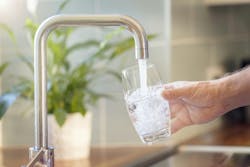The United States has historically used lead pipes to distribute water throughout the country. It was not until later that their harmful effects were uncovered. In 2020, the U.S., Environmental Protection Agency (EPA) set a September 1, 2023 deadline for the new lead content requirements outlined in the “Lead Free” Rule, which was expanded to include point-of-use drinking water treatment devices. Every manufacturer of products that come into contact with drinking water, including those for sinks, under-the-sink, and counter devices, is impacted and must comply with the new requirements for “Lead Free” plumbing.
The new rule outlines that manufacturers are required to be certified to NSF/ANSI/CAN 372: Drinking Water System Components – Lead Content. However, manufacturers who have not certified their products before might not know what to expect. With the deadline quickly approaching, manufacturers not yet certified will need to understand the steps involved in certification to speed up the process, so they can earn and maintain compliance with the new regulation and continue to sell their products in the marketplace.
NSF/ANSI 372 overview
The NSF/ANSI 372 American National Standard establishes a standardized methodology for evaluating and ensuring compliance with lead content limits. The standard is consistent with the United States Safe Drinking Water Act (SDWA) and its lead-free plumbing requirements. The requirements in the standard include a calculation of the weighted average of a product’s lead content prior to testing, specific testing procedures for verifying lead content, and requirements for products to have a max weighted lead content of 0.2 percent for solders and fluxes and 0.25 percent for all other products. The standard also restricts the use of lead as an intentional ingredient in products, components, materials or their coatings.
Products covered under the standard's scope include coatings, valves, pipes, gaskets, solder and flux fittings, faucets, water filters, water softeners, reverse osmosis systems, ultraviolet reactors, and water meters. If you are a manufacturer of a point-of-use product in the standard’s scope, the September 1, 2023, deadline applies to you and will affect your product's ability to be sold in the U.S.
The certification process
The road to becoming certified includes several steps: providing product documentation; an onsite audit; product testing; the certification decision, which includes adjusting any non-conformities, if applicable; and ongoing monitoring. Manufacturers will need to be prepared for each step and have the necessary documents ready, so the process is not stalled.
Compile Product Documentation
The first step for certification is a manufacturer applying for certification with the certification body. Quickly after the application is in, manufacturers must provide documents that include information on the product formulation, including the lead content of materials, supplier information, and surface area of wetted parts. The information in these documents is used to evaluate testing requirements and provides a basis for auditors to compare against actual production records.
Product Testing
After obtaining product information, a technical evaluation is conducted to determine test requirements, and samples are requested from the manufacturer. Once the samples are received, they are tested for lead content and a report of the results is provided. The product must meet the standard requirements outlined in NSF/ANSI 372 to pass and earn certification.
Prepare for Onsite Audit
The certification body’s auditors will visit the manufacturing facility to ensure compliance with the standard’s requirements and confirm that product information submitted in the application matches production records. This step allows auditors to better understand the manufacturing equipment, process and practices used by the manufacturer. Additionally, auditors will speak to key staff and review the quality control methods used in the facility.
Certification Decision
If the product does not meet the NSF/ANSI 372 requirements and therefore does not receive certification, the manufacturer will have the opportunity to fix any non-conformances they received. Once the product has been adjusted, the manufacturer can resubmit their product for further testing.
If the product does meet the standard requirements, it will earn certification. In the case of NSF certification, the certification mark provides assurance the product was impartially reviewed to the standard, verifies product labeling, and demonstrates an organization’s commitment to quality, compliance and safety. It will also allow products to continue to be sold under the EPA’s new rule.
Monitoring
It is important for manufacturers to understand that after initial certification, the certification body will conduct an annual audit of manufacturing facilities and conduct periodic retesting on the certified product. This helps ensure the products continue to meet the standard and low lead requirements. This step is especially important in protecting public health as product formulations, and their manufacturing process sometimes changes.
Want to speed up the process?
The water market is competitive as manufacturers work to fill orders that contribute to delivering drinking water across the US. The certification process takes time, so it is imperative for manufacturers who still need to earn certification to be as prepared as possible to avoid being unable to sell their products in the US. For more information or help getting your products certified, please contact NSF at [email protected].



